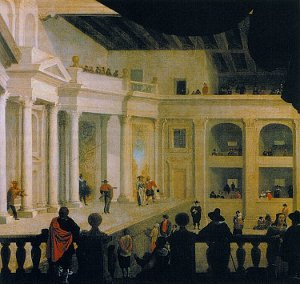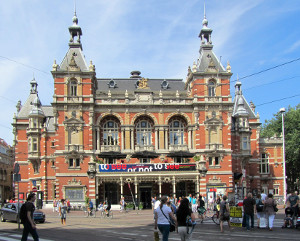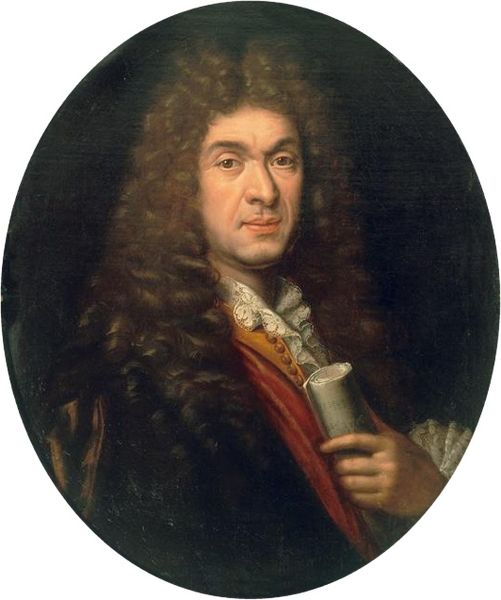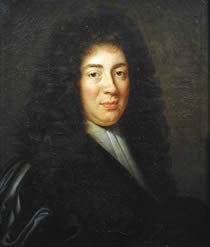At the beginning of the seventeenth century, the development of dramatic theatre art was in the hands of so-called Rederijkerskamers (rhetorical societies) established by members of the wealthy burgher class. The first Rederijkerskamers in Amsterdam took place at the Oude Kamer van Rethorycke. But a small group of progressive poets and playwrights (Samuel Coster, Gebrand Adriaensz. Bredero and Pieter Cornelisz. Hooft) wished to improve and widen the range of plays and their performance. Above all, they wished to introduce the Dutch language on the stage instead of the commonly used Latin. In September 1617, they established under the leadership of Costers the Eerste Nederduytsche Academie. But soon after, the activities of the Academie, which included scientific lectures in the Dutch language and hidden criticism of Calvinists' clerical fanaticism, met with the strong resistance from the Calvinist clergy.
The early death of Bredero 1618, along with tragic political incidents such as the execution of the statesman and "landsadvokaat" Johan van Oldenbarnevelt (May 13, 1619), diminished the chances for the Academie's growth. Scientific lectures were prohibited. Joost van den Vondel's Vraghe van d'Amsterdamsche Academie aan alle poëten en dichters ("Question from the Amsterdam Academy to all poets and writers") in 1631 caused vehement reaction by the Calvinists. Despite these pressures, the city established an Athenaeum Illustre, a kind of educational link between the Latin Schools and a university,Frits Noske, Music Bridging Divided Religions. The Motet in the Seventeenth-Century Dutch Republic, vol. I (Wilhelmshaven, 1989), 14. which in effect, was one of the Academy's aims. But still, lectures were not held in Dutch.

Hans Jurriaensz. van Baden
1653
Theaterinstituut Nederland

In 1638, the newly built Schouwburg (fig. 1 & 2) (city theatre) opened in Amsterdam at the Keizersgracht. It was constructed by the famous architect Jacob van Campen (1596–1657). But its wooden construction was 134 years later one of the reasons for the disastrous burning of the entire building in 1772.
The opening play in 1638 was Joost van den Vondel(1587–1679)'s exclusively written tragedy Gysbrecht van Aemstel which became from this moment on the traditional New Year's performance. The introduction of a musical theatre followed later. The first opera in the Republic of the Seven United Provinces took place at 25th November 1677 with the Isis written by the famous Italian-French composer Jean-Baptiste Lully (1632–1687) (fig. 3) and his librettist Philippe Quinault (1635–1688) (fig. 4), the creators of the French Tragédie en musique.Tragédie en musique, also known as "tragédie lyrique," is a genre of French opera that developed during the Baroque period. It combines elements of the classical French tragedy (based on themes from ancient Greek and Roman myth and history) with music, dance, and spectacle. Tragédie en musique typically consists of five acts, with a prologue that often includes allegorical content. The music blends French and Italian stylistic elements. It features a combination of recitative (narrative singing), arias (solo songs), choruses, and dances, with instrumental overtures and interludes. The opera was probably performed by a French company in connection with the Nijmegen peace negotiations. This performance was the first in the Amsterdamse Schouwburg after it had been closed five years earlier due to the war between the Dutch Republic and France, England and Münster. In 1665, the first actress appeared in the Amsterdam theatre, strenghtening the clergy's view that it was the sink of the vilest iniquity.Simon Schama, The Embarrassment of Riches (New York: Harpercollins Publishers, 1987), 408.
The development of the opera in Italian and French Royal court were closely followed by Dutch muscial connoisseurs. The question was now how to found and run their own native company. This was the chance for Dirck (Theodoro) Strijcker, son of Jacob Strijcker, the Netherlands consul in Venice. Dirck was raised in Venice where he was exposed to the opera. In 1679, he made a contract with the heads of Amsterdam's Burgerweeshuis (municipal orphan asylum) and the Oude-Mannenhuis (Old Man's Almshouse)—called the Godshuizen—since theatre companies were required to alot part of their profits to these social organizations.
 Fig. 3 Jean-Baptiste Lully
Fig. 3 Jean-Baptiste LullyNicolas Mignard
17th century
Oil on canvas, 122 × 155 cm.
Musée Condé, Chantilly, Oise

French school
Strijcker's project took more than two years to complete. At first, a suitable building had to be built. Then, stage craftsmen and well-trained singers had to be found. The musical theatre was opened on 31st December 1681 with the Le fatiche d'Ercole per Deianira. We don't know whether it was a success, and we have no information about the programme of Strijcker's theatre, nor about its members except the names of two singers: the Italian Matteo Battaglia and his wife Eleonora. Strijcker had "borrowed" them from the court in Düsseldorf. We do know of a few famous visitors and the dates on which they attended the opera: prince Willem III with his wife Maria Stuart at February 7, 1682, Constantijn Huygens at February 26. Le fatiche ran until 5th March 1682. Then Strijcker closed his theatre for some weeks.
He re-opened it in May with Helena rapita da Paride, again with the libretto by Aureli and the music by Domenico Freschi, arranged by Pietro Antonio Fiocco, a young Italian who had come with Strijcker to Amsterdam and went later to Brussels. Helena ran until June, then again, the theatre was closed due to its elevated costs. Strijcker even asked the mayor to be released from payment for the Godshuizen, which was granted to him. But this implied the end of his theatre project. Only 75 years later (1750), other Italian operas (rather then opere buffe) were performed on Netherlandish stages.
The Hague with its aristocratic residences, was another center for the opera. For the most part, new French operas ones were favored (Lully's operas were more popular in The Hague than in Amsterdam). In 1702 Louis Deseschaliers established his theatre company here, half a century earlier than in Amsterdam.
Between 1681 and 1750, French cultural influence in the Dutch Republic was remarkable—despite the continual wars between the two countries. French operas were well known and frequently performed on Dutch stages, in most cases by foreign companies. Here, Jan Baptiste Lully, with his librettist Quinault, established together a new style called Tragédie en musique or Tragédie lyrique. Among his most successful operas were Cadmus & Hermione 1673, Atys 1676 and Armide in1686. He favored an overture, a prologue followed by five acts and his subject matters drawn from the ancient mythology. The splendid, enchanting stage sets were renowned. Lully's new style marks the beginning of the national French opera. France played now—along with Italy—a leading role in the European musical theatre scene. Lully was named the "Surintendant de la musique du Roi" at the court of Louis XIV. Numerous collections of the most famous arias or instrumental pieces were published in the Netherlands during that time, including Quinault's libretti.
Although it was almost impossible to establish an independent national Dutch opera, there were a few composers (not all Dutch born) who developed a special, "lighter" kind of musical theatre: the zangspel, a theatre play with a mixture of spoken texts and arias, duets or choruses. The composer of the first zangspel was Carolus Hacquart (born c. 1640 in Bruges, died c. 1701). He wrote the music to a poem by Dirk Buysero, De Triomfeerende Min on the occasion of the Peace of Nijmegen (1678), but it was never performed, perhaps because Buysero stood on the "wrong" side of Amsterdam's theatre scene.Louis Peter Grijp, "Dutch Music of the Golden Age," in Music & Painting in the Golden Age, eds. Edwin Buijsen and Peter Louis Grijp (Zwolle: Waanders Books, 1996), 75.
Johannes Schenck (born 1660 Amsterdam, died after 1716) also wrote music for one of the earliest zangspelen. He was active as a viola da gamba player and composer in Amsterdam before he entered the service at the court of Wilhelm, Elector Palatine in Düsseldorf, in 1696. During his stay in Amsterdam he composed the Ceres, Bacchus and Venus with text by Goverd Bidloo, performed from November 1686 to February 1687 at the Stadsschouwburg. The airs were published separately as Eenige gezangen uit de opera van Bacchus, Ceres en Venus (Amsterdam 1687).
In 1688, the short singspiel De vryadje van Cloris en Roosje with the music by Servaas Koninck (1654–1701) premièred in Amsterdam. It was thereafter performed every Christmas from 1708 to 1772, together with Joost van den Vondel's tragedy Gysbrecht van Aemstel. During his stay in Amsterdam, Koninck was employed by the Stadsschouwburg to play incidental music before, during and between the acts of plays.
Hendrik Anders (c. 1657–1714), composer of German birth, settled in Amsterdam, where he served from 1683 to 1694 as organist of the Lutheran church. From this time until his death, his name occurs in the records of the Amsterdam Stadsschouwburg. He composed instrumental ensemble music (possibly intended as introductory and entr'acte music for the city theatre) and the music for five Dutch zangspelen with the texts by A. du Moulin, Dirk Buysero, and Cornelis Sweerts.
These "light" operas were highly successful and, above all, introduced the Dutch language into the musical theatre. Thomas Arendsz's tradegy Roelant was a Dutch adaptation of Lully's/Quinault's opera Roland. The text was spoken but some of the arias were kept and sung to Lully's music. The première was in 1685.
Despite all these efforts and apparent popular success, a true national Dutch opera did not develop. Most operas on Dutch stages came from France or Italy (and later from German speaking area—Mozart) and were performed by foreign companies. One plausable explanation for this might be that towards the end of the century, Dutch patricians and aristocrats had become increasing influenced by foreign cultural movements. And this caused a gradual decline in the importance of the city musicians.Louis Peter Grijp, "Dutch Music of the Golden Age," in Music & Painting in the Golden Age, eds. Edwin Buijsen and Peter Louis Grijp (Zwolle: Waanders Books, 1996), 78.